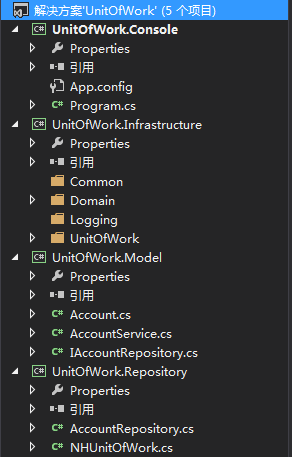企业模式之Unit Of Work模式
在开始UnitOfWork模式之前有必要回顾下我们耳熟能详的Data Access Object(DAO)模式,即数据访问对象。DAO是一种简单的模式,我们构建应用的时候经常会使用到它,它的功能就是将DAL元素从应用程序中分离出来,在经典的三层架构中,我们会将数据持久化工作单独分离出来,封装成DAL层。但是,DAO并没有隐藏它面对是一张张数据表,而且通常情况我们会为数据库中的每一张表创建一个DAO类,想必大家对这种方式的极度的不爽了,。
由于DAO模式与数据表是一对一匹配的关系,因此DAO模式很好的配合了Active Record和Transaction Script业务模式,尤其是Table Module。正因为这种与数据表一对一匹配关系,使我对DAO模式深恶痛绝。
Unit Of Work模式,即工作单元,它是一种数据访问模式。它是用来维护一个由已经被业务修改(如增加、删除和更新等)的业务对象组成的列表。它负责协调这些业务对象的持久化工作及并发问题。那它是怎么来维护的一系列业务对象组成的列表持久化工作的呢?通过事务。Unit Of Work模式会记录所有对象模型修改过的信息,在提交的时候,一次性修改,并把结果同步到数据库。 这个过程通常被封装在事务中。所以在DAL中采用Unit Of Work模式好处就在于能够确保数据的完整性,如果在持有一系列业务对象(同属于一个事务)的过程中出现问题,就可以将所有的修改回滚,以确保数据始终处于有效状态,不会出现脏数据。
在这里我们,使用一个简单的银行领域对两个帐号之间的转账进行举例
首先如图进行分层搭建基础框架

总共分为四层依次是: ---> 引用关系
UnitOfWork.Console --->UnitOfWork.Infrastructure、UnitOfWork.Model、UnitOfWork.Repository
UnitOfWork.Infrastructure
UnitOfWork.Model --->UnitOfWork.Infrastructure
UnitOfWork.Repository --->UnitOfWork.Model、UnitOfWork.Infrastructure
这不是经典的领域驱动架构,因为业务简单就进行简单搭建。
UnitOfWork.Infrastructure:
首先,在UnitOfWork.Infrastructure建了一个Domain文件夹,里面只建了一个IAggregateRoot接口,Unit Of Work操作的实体必须是实现IAggregateRoot接口的。

/// <summary>
/// 标识接口,定义聚合根
/// </summary>
public class IAggregateRoot
{ }

建立UnitOfWork文件夹,在里面添加一个IUnitOfWorkRepository接口

public interface IUnitOfWorkRepository
{
//新增
void PersistCreationOf(IAggregateRoot entity);
//更新
void PersistUpdateOf(IAggregateRoot entity);
//删除
void PersistDeletionOf(IAggregateRoot entity);
}

我们再向UnitOfWork文件夹中添加一个IUnitOfWork接口,IUnitOfWork接口在注册更新、新增和删除时,需要IUnitOfWorkRepository,这样再提交Commit,UnitOfWork可以将真正持久化的工作委托给适合的具体实现对象,其实就是将持久化工作交给了IUnitOfWorkRepository的实现类,我们稍后看看IUnitOfWork的实现类你就清楚了。

public interface IUnitOfWork
{
/// <summary>
/// 更新
/// </summary>
/// <param name="entity"></param>
/// <param name="unitofWorkRepository"></param>
void RegisterUpdate(IAggregateRoot entity, IUnitOfWorkRepository unitofWorkRepository);
/// <summary>
/// 新增
/// </summary>
/// <param name="entity"></param>
/// <param name="unitofWorkRepository"></param>
void RegisterAdd(IAggregateRoot entity, IUnitOfWorkRepository unitofWorkRepository);
/// <summary>
/// 删除
/// </summary>
/// <param name="entity"></param>
/// <param name="unitofWorkRepository"></param>
void RegisterRemoved(IAggregateRoot entity, IUnitOfWorkRepository unitofWorkRepository);
/// <summary>
/// 提交
/// </summary>
void Commit();
}

顺便说一句,在UnitOfWork.Infrastructure,我还建立的Common文件夹,Logging文件夹,所要表达的意思是Infrastructure意为基础设施层,我们可以将通用的组件放到这里面,比如日志组件,邮件组件等。
好了,回顾下,我们在UnitOfWork.Infrastructure中其实什么业务都没有处理,只定义了三个接口。
UnitOfWork.Model
接下来,说说这层干了什么事吧!这一层主要是处理两个账户之间转账的业务。
向UnitOfWork.Model中添加一个Account类,实现IAggregateRoot接口,表示它是一个聚合根,可以被Unit Of Work操作。

/// <summary>
/// 账户类,表示Account是集合根
/// </summary>
public class Account : IAggregateRoot
{
public Account(decimal balance)
{
Balance = balance;
}
/// <summary>
/// 账户余额
/// </summary>
public decimal Balance { get; set; }
}

为了持久化Account类,我们添加的一个仅包含了示例有关的的Repository接口,即IAccountRepository,只是简单的示例。

/// <summary>
/// 定义持久化操作
/// </summary>
public interface IAccountRepository
{
/// <summary>
/// 更新
/// </summary>
/// <param name="account"></param>
void Save(Account account);
/// <summary>
/// 新增
/// </summary>
/// <param name="account"></param>
void Add(Account account);
/// <summary>
/// 删除
/// </summary>
/// <param name="account"></param>
void Remove(Account account);
}

为了完成转账的业务,我们需要创建一个服务类来协调两个账户之间的转账工作,如AccountService类,在AccountService类中,通过构造函数初始化了IAccountRepository和IUnitOfWork。在完成转账后,它们都调用了账户Repository进行持久化。最后,通过Unit Of Work的Commit来确保该笔交易的完成。

public class AccountService
{
private IAccountRepository _accountRepository;
private IUnitOfWork _unitOfWork; public AccountService(IAccountRepository accountRepository,
IUnitOfWork unitOfWork)
{
_accountRepository = accountRepository;
_unitOfWork = unitOfWork;
} /// <summary>
/// 转账
/// </summary>
/// <param name="from"></param>
/// <param name="to"></param>
/// <param name="amount"></param>
public void Transfer(Account from, Account to, decimal amount)
{
if (from.Balance >= amount)
{
from.Balance -= amount;
to.Balance += amount; _accountRepository.Save(from);
_accountRepository.Save(to);
_unitOfWork.Commit();
}
}
}

总结下,在UnitOfWork.Model中我们定义的一个Account类,定义了一个持久化Account类的接口,以及转账业务的完成。下面我们要进入UnitOfWork.Repository探究Repository和Unit Of Work之间是怎么交互的?
UnitOfWork.Repository:
在UnitOfWork.Repository,添加了一个NHUnitOfWork类,实现了UnitOfWork.Infrastructure.UnitOfWork中的IUnitOfWork接口,为什么定义到这里。因为在项目开发中你可能有NHbernator的Repository和EF的Repository。还记得我在讲解IUnitOfWork接口时,曾说过这样一句话“IUnitOfWork将持久化工作交给了IUnitOfWorkRepository的实现类”,在这里你就会找到答案了。

public class NHUnitOfWork : IUnitOfWork
{
private Dictionary<IAggregateRoot, IUnitOfWorkRepository> addedEntities;
private Dictionary<IAggregateRoot, IUnitOfWorkRepository> changedEntities;
private Dictionary<IAggregateRoot, IUnitOfWorkRepository> deletedEntities; public NHUnitOfWork()
{
addedEntities = new Dictionary<IAggregateRoot, IUnitOfWorkRepository>();
changedEntities = new Dictionary<IAggregateRoot, IUnitOfWorkRepository>();
deletedEntities = new Dictionary<IAggregateRoot, IUnitOfWorkRepository>();
} public void RegisterUpdate(IAggregateRoot entity, IUnitOfWorkRepository unitofWorkRepository)
{
if (!changedEntities.ContainsKey(entity))
{
changedEntities.Add(entity, unitofWorkRepository);
}
} public void RegisterAdd(IAggregateRoot entity, IUnitOfWorkRepository unitofWorkRepository)
{
if (!addedEntities.ContainsKey(entity))
{
addedEntities.Add(entity, unitofWorkRepository);
};
} public void RegisterRemoved(IAggregateRoot entity, IUnitOfWorkRepository unitofWorkRepository)
{
if (!deletedEntities.ContainsKey(entity))
{
deletedEntities.Add(entity, unitofWorkRepository);
}
} public void Commit()
{
using (TransactionScope scope = new TransactionScope())
{
foreach (IAggregateRoot entity in this.addedEntities.Keys)
{
this.addedEntities[entity].PersistCreationOf(entity);
} foreach (IAggregateRoot entity in this.changedEntities.Keys)
{
this.changedEntities[entity].PersistUpdateOf(entity);
} foreach (IAggregateRoot entity in this.deletedEntities.Keys)
{
this.deletedEntities[entity].PersistDeletionOf(entity);
} scope.Complete();
}
}

接下来,再添加一个AccountRepository类,这个类实现了两个接口,IAccountRepository和IUnitOfWorkRepository接口。IAccountRepository中的方法就是简单得将工作交给了Unit Of Work,传入待持久化的实体及Repository(实现了IUnitOfWorkRepository)引用。最后Unit Of Work 引用Repository的IUnitOfWorkRepository契约来完成真正的持久化工作。

public class AccountRepository : IAccountRepository,IUnitOfWorkRepository
{
private IUnitOfWork _unitOfWork; public AccountRepository(IUnitOfWork unitOfWork)
{
_unitOfWork = unitOfWork;
} public void Save(Account account)
{
_unitOfWork.RegisterUpdate(account, this);
} public void Add(Account account)
{
_unitOfWork.RegisterAdd(account, this);
} public void Remove(Account account)
{
_unitOfWork.RegisterRemoved(account, this);
} public void PersistUpdateOf(IAggregateRoot entity)
{
// ADO.net code to update the entity...真正的SQL实现
} public void PersistCreationOf(IAggregateRoot entity)
{
// ADO.net code to Add the entity...真正的SQL实现
} public void PersistDeletionOf(IAggregateRoot entity)
{
// ADO.net code to delete the entity...真正的SQL实现
}
}

总结下,UnitOfWork.Repository这里才是真正纠结的地方。首先,Unit Of Work加载实体对象(Accont)和实体对应的Repository对象(AccountRepository);然后通过Unit Of Work的Commit方法,循环转调Repository对象(AccountRepository)的持久化方法,进行实体对象(Accont)的持久化工作。多调试就明白了。
UnitOfWork.Console:
接下来,就是最后的控制台程序了。

class Program
{
static void Main(string[] args)
{
Account a = new Account(1000);
System.Console.WriteLine("现在张三,存有{0}", a.Balance);
Account b = new Account(200);
System.Console.WriteLine("现在李四,存有{0}", b.Balance);
System.Console.WriteLine("张三准备转500元给李四,转战开始了......"); //声明要使用的UnitOfWork
IUnitOfWork nhUnitOfWork = new NHUnitOfWork(); //声明要使用的Repository
IAccountRepository accountRepository = new AccountRepository(nhUnitOfWork); AccountService service = new AccountService(accountRepository, nhUnitOfWork); service.Transfer(a,b,500);
System.Console.WriteLine("转账结束");
System.Console.WriteLine("张三当前余额:{0}",a.Balance);
System.Console.WriteLine("李四当前余额:{0}",b.Balance); System.Console.ReadKey();
}
}

企业模式之Unit Of Work模式的更多相关文章
- Entity Framework中的Identity map和Unit of Work模式
阅读目录: 一.什么是Identity map模式 二.关于Identity map模式的验证示例 三.Unit of Work 模式 四.总结和注意的问题 一,什么是Identity map模式 I ...
- 在Entity Framework 4.0中使用 Repository 和 Unit of Work 模式
[原文地址]Using Repository and Unit of Work patterns with Entity Framework 4.0 [原文发表日期] 16 June 09 04:08 ...
- Entity Framework中的Identity map和Unit of Work模式(转)
一,什么是Identity map模式 Identity map是EF获取和缓存数据的模式.Identity map模式指的是任何数据都只会被加载一次,以map的形式缓存,以唯一的identity来再 ...
- [转载]Linux运行模式及紧急、救援模式
运行模式 在Linux中,存在一个叫init(initialize)的进程,其进程号是1,该进程存在一个对应的配置文件inittab,叫做系统的运行级别配置文件,位置在/etc/inittab.(但是 ...
- MIT 6.828 JOS学习笔记6. Appendix 1: 实模式(real mode)与保护模式(protected mode)
在我们阅读boot loader代码时,遇到了两个非常重要的概念,实模式(real mode)和保护模式(protected mode). 首先我们要知道这两种模式都是CPU的工作模式,实模式是早期C ...
- 《JAVA与模式》之抽象工厂模式
场景问题 举个生活中常见的例子——组装电脑,我们在组装电脑的时候,通常需要选择一系列的配件,比如CPU.硬盘.内存.主板.电源.机箱等.为讨论使用简单点,只考虑选择CPU和主板的问题. 事实上,在选择 ...
- Windows Azure Cloud Service (41) 修改云服务IIS托管管道模式为4.0经典模式
<Windows Azure Platform 系列文章目录> 这是笔者在之前的项目中遇到的问题,做一下总结,给网友做参考. 在一般情况下,Visual Studio开发的Cloud Se ...
- php模式设计之 注册树模式
在前两篇单例模式和工厂模式后,终于迎来了最后一个基础的设计模式--注册树模式. 什么是注册树模式? 注册树模式当然也叫注册模式,注册器模式.之所以我在这里矫情一下它的名称,是因为我感觉注册树这个名称更 ...
- 《JAVA与模式》之享元模式
<JAVA与模式>之享元模式 在阎宏博士的<JAVA与模式>一书中开头是这样描述享元(Flyweight)模式的: Flyweight在拳击比赛中指最轻量级,即“蝇量级”或“雨 ...
随机推荐
- GLSL语言基础
from http://www.kankanews.com/ICkengine/archives/120870.shtml 变量 GLSL的变量命名方式与C语言类似.变量的名称可以使用字母,数字以及下 ...
- 【练习】flashback基于scn的闪回查询
1.创建表dept1: :: SCOTT@ORA11GR2>create table dept1 as select * from dept; Table created. :: SCOTT@O ...
- Ms sql pivot unpivot
--建表 create table dbo.orders ( orderid int not null primary key nonclustered, orderdate datetime not ...
- php六种基础算法:冒泡,选择,插入,快速,归并和希尔排序法
$arr(1,43,54,62,21,66,32,78,36,76,39); 1. 冒泡排序法 * 思路分析:法如其名,就是像冒泡一样,每次从数组当中 冒一个最大的数出来. * 比 ...
- 【转】java的socket编程
转自:http://www.cnblogs.com/linzheng/archive/2011/01/23/1942328.html 一,网络编程中两个主要的问题 一个是如何准确的定位网络上一台或多台 ...
- win7出现无法连接到代理服务器的错误,不能上网的问题的解决
今天晚上突然停电,等我打开电脑发现不然上网,用google浏览器出现这个错误: 用IE诊断错误如下: 说是不能连到代理服务器,但是我没有连接到代理服务器啊,但是我的QQ能登,就是不能用浏览器上网,经过 ...
- ESL python调用C模块时传递unicode字符串报错问题解决
在是用freeswitch时利用ESL的python调用时传递字符串报错 TypeError: in method 'ESLconnection_api', argument 2 of type 'c ...
- Python 之Django
1.安装Django(下载慢的时候用MaxVPN) pip3 install django 2.Django处理流程 新建project(mysite),执行dj(mysite),然后在console ...
- 《深入理解Nginx》阅读与实践(二):配置项的使用
前文链接:<深入理解Nginx>阅读与实践(一):Nginx安装配置与HelloWorld HelloWorld的完成意味着已经踏入了nginx的大门,虽然很振奋人心,但在编写中仍有很多疑 ...
- format when printing
http://msdn.microsoft.com/en-us/library/vstudio/56e442dc.aspx %[flags] [width] [.precision] [{h | l ...
